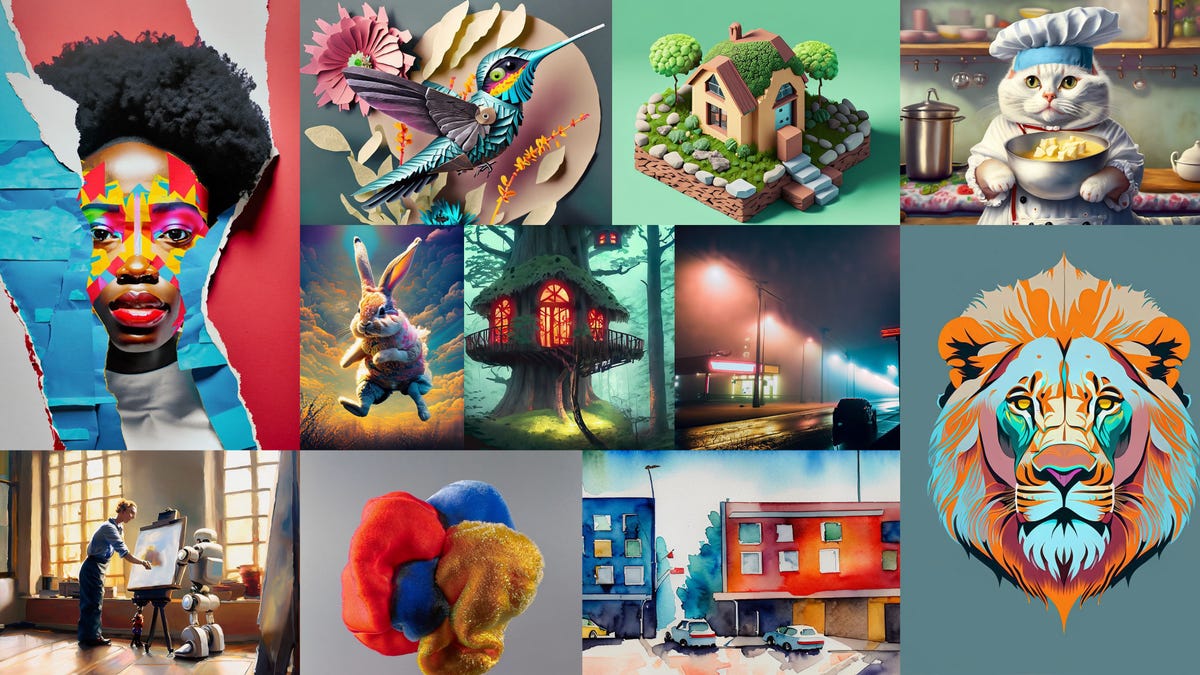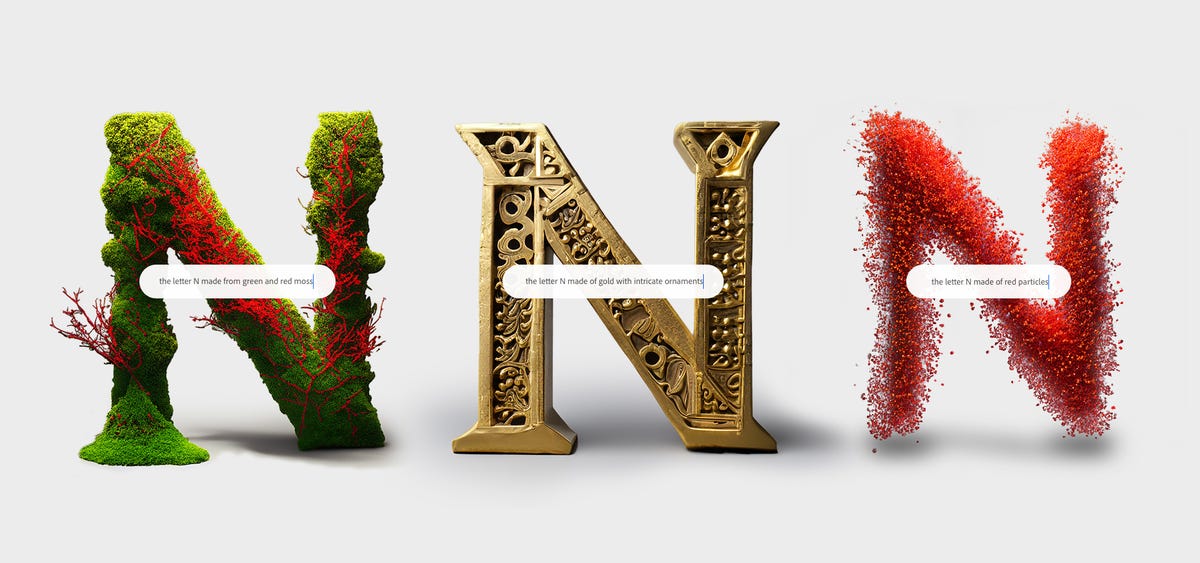Technologies
Adobe: Our New Generative AI Will Help Creative Pros, Not Hurt Them
The Firefly tools begin with image creation and font styling but soon will spread to Photoshop and other software.

In 2022, OpenAI’s Dall-E service wowed the world with the ability to turn text prompts into images. Now Adobe has built its own version of this generative AI technology with tools that begin a technological overhaul of the company’s widely used creative tools.
On Tuesday, Adobe released the first two members of its new Firefly collection of generative AI tools for beta testing. The first tool creates an image based on a text prompt like «fierce alligator leaping out of the water during a lightning storm,» with hundreds of styles that can tweak results. The other applies prompt-based styles to text, letting people create letters that look hairy, scaly, mossy or however else they want.
Firefly for now is available on Adobe’s website, but the company will build generative AI directly into other tools, starting with its Photoshop image editing software, Illustrator for designs and Adobe Express for creating quick videos. The company hasn’t revealed its pricing approach for the new tools.
Creative professionals might see Firefly as an incursion into their creative domain, going beyond mechanical tools like selecting colors and trimming videos into the heart and soul of their jobs. With AI showing new smarts when it comes to translating documents, interpreting tax code, composing music and creating travel itineraries, it’s not irrational for professionals to feel spooked.
Like other AI fans, though, Adobe sees artificial intelligence as the latest digital tool to amplify what humans can do. For example, Firefly eventually could let people use Adobe tools to tailor designs to individuals instead of just creating one design for a broad audience, said Alexandru Costin, vice president of Adobe’s generative AI work.
«We don’t think AI will replace creative creators. We think that creators using AI will be more competitive than creators not using AI. This is why we want to bring AI to the fingertips of all our user base,» Costin said. «The only way to succeed in AI is to embrace it.»
Adobe’s Firefly products are trained from the company’s own library of stock images, along with public domain and licensed works. The company has worked to reduce the bias in training data that AI models can reflect, for example that business executives are male.
AI is a «sea change»
Artificial intelligence uses processes inspired by human brains for computing tasks, trained to recognize patterns in complex real-world data instead of following traditional and rigid if-this-then-that programming. With advances in AI hardware, software, algorithms and training data, the field is advancing rapidly and touching just about every corner of tech.
The latest flavor of the technology, generative AI, can create new material on its own. The best known example, ChatGPT, can write software, hold conversations and compose poetry. Microsoft is employing ChatGPT’s technology foundation, GPT-4, to boost Bing search results, offer email writing tips and help build presentations
AI tools are sprouting up all over. Adobe has used AI for years under its Sensei brand for features like recognizing human subjects in Lightroom photos and transcribing speech into text in Premiere Pro videos. EbSynth applies a photo’s style to a video, HueMint creates color palettes and LeiaPix converts 2D photos into 3D scenes.
But it’s the new generative AI that brings new creative possibilities to digital art and design.
«It’s a sea change,» said Forrester analyst David Truog.


One of the first members of Adobe’s Firefly family of generative AI tools will style text based on prompts like «the letter N made of gold with intricate ornaments.»
AdobeAlpaca offers a Photoshop plug-in to generate art, and Aug X Labs can turn a text prompt into a video. Google’s MusicLM converts text to music, though it’s not open to the public. Dall-E captured the internet’s attention with its often fantastical imagery — the name marries Pixar’s WALL-E robot with the surrealist painter Salvador Dalí.
Related tools like Midjourney and Stability AI’s Stable Diffusion spread the technology even further.
If Adobe didn’t offer generative AI abilities, creative pros and artists would get them from somewhere else.
Indeed, Microsoft on Tuesday incorporated Dall-E technology with its Bing Image Creator service.
Training AIs isn’t easy, but it’s getting less difficult, at least for those who have a healthy budget. Chip designer Nvidia on Tuesday announced that Adobe is using its new H100 Hopper GPU to train Firefly models through a new service called Picasso. Other Picasso customers include photo licensing companies Getty Images and Shutterstock.
Legal engineering
Developing good AI isn’t just a technical matter. Adobe set up Firefly to sidestep legal and social problems that AI poses.
For example, three artists sued Stability AI and Midjourney in January over the use of their works in AI training data. They «seek to end this blatant and enormous infringement of their rights before their professions are eliminated by a computer program powered entirely by their hard work,» their lawsuit said.
Getty Images also sued Stability AI, alleging that it «unlawfully copied and processed millions of images protected by copyright.» It offers licenses to its enormous catalog of photos and other images for AI training, but Stability AI didn’t license the images. Stability AI, DeviantArt and Midjourney didn’t respond to requests for comment.
Adobe wants to assure artists that they needn’t worry about such problems. There are no copyright problems, no brand logos, and no Mickey Mouse characters. «You don’t want to infringe somebody else’s copyright by mistake,» Costin said.
The approach is smart, Truog said.
«What Adobe is doing with Firefly is strategically very similar to what Apple did by introducing the iTunes Music Store 20 years ago,» he said. Back then, Napster music sharing showed demand for online music, but the recording industry lawsuits crushed the idea. «Apple jumped in and designed a service that let people access music online but legally, more easily, and in a way that compensated the content creators instead of just stealing from them.»
Adobe also worked to counteract another problem that could make businesses leery, showing biased or stereotypical imagery.
It’s now up to Adobe to convince creative pros that it’s time to catch the AI wave.
«The introduction of digital creativity has increased the number of creative jobs, not decreased them, even if at the time it looked like a big threat,» Costin said. «We think the same thing will happen with generative AI.»
Editors’ note: CNET is using an AI engine to create some personal finance explainers that are edited and fact-checked by our editors. For more, see this post.
Technologies
Today’s NYT Strands Hints, Answers and Help for Jan. 5 #673
Here are hints and answers for the NYT Strands puzzle for Jan. 5, No. 673.

Looking for the most recent Strands answer? Click here for our daily Strands hints, as well as our daily answers and hints for The New York Times Mini Crossword, Wordle, Connections and Connections: Sports Edition puzzles.
Today’s NYT Strands puzzle could be a challenge. Some of the answers are difficult to unscramble, so if you need hints and answers, read on.
I go into depth about the rules for Strands in this story.
If you’re looking for today’s Wordle, Connections and Mini Crossword answers, you can visit CNET’s NYT puzzle hints page.
Read more: NYT Connections Turns 1: These Are the 5 Toughest Puzzles So Far
Hint for today’s Strands puzzle
Today’s Strands theme is: Slapped together
If that doesn’t help you, here’s a clue: When you don’t take your time.
Clue words to unlock in-game hints
Your goal is to find hidden words that fit the puzzle’s theme. If you’re stuck, find any words you can. Every time you find three words of four letters or more, Strands will reveal one of the theme words. These are the words I used to get those hints but any words of four or more letters that you find will work:
- SKIT, SWIPE, SWIPES, DIPS, SIPS, DIRT, GRAND, SPEED, QUICK
Answers for today’s Strands puzzle
These are the answers that tie into the theme. The goal of the puzzle is to find them all, including the spangram, a theme word that reaches from one side of the puzzle to the other. When you have all of them (I originally thought there were always eight but learned that the number can vary), every letter on the board will be used. Here are the nonspangram answers:
- BRISK, SWIFT, SPEEDY, FILTHY, GRUBBY, STAINED
Today’s Strands spangram
Today’s Strands spangram is QUICKANDDIRTY. To find it, start with the Q that’s three letters down on the farthest right row, and wind backwards and down.
Don’t miss any of our unbiased tech content and lab-based reviews. Add CNET as a preferred Google source.
Technologies
Today’s NYT Connections Hints, Answers and Help for Jan. 5, #939
Here are some hints and the answers for the NYT Connections puzzle for Jan. 5 #939.

Looking for the most recent Connections answers? Click here for today’s Connections hints, as well as our daily answers and hints for The New York Times Mini Crossword, Wordle, Connections: Sports Edition and Strands puzzles.
Today’s NYT Connections puzzle has a tough purple category, to no one’s surprise. Read on for clues and today’s Connections answers.
The Times has a Connections Bot, like the one for Wordle. Go there after you play to receive a numeric score and to have the program analyze your answers. Players who are registered with the Times Games section can now nerd out by following their progress, including the number of puzzles completed, win rate, number of times they nabbed a perfect score and their win streak.
Read more: Hints, Tips and Strategies to Help You Win at NYT Connections Every Time
Hints for today’s Connections groups
Here are four hints for the groupings in today’s Connections puzzle, ranked from the easiest yellow group to the tough (and sometimes bizarre) purple group.
Yellow group hint: Facebook tasks.
Green group hint: Way far away.
Blue group hint: Think museum displays.
Purple group hint: Letter near the end of the alphabet.
Answers for today’s Connections groups
Yellow group: Things you can do on social media.
Green group: Furthest point.
Blue group: Art movements, with «ism.»
Purple group: What «V» might mean.
Read more: Wordle Cheat Sheet: Here Are the Most Popular Letters Used in English Words
What are today’s Connections answers?
The yellow words in today’s Connections
The theme is things you can do on social media. The four answers are comment, like, lurk and post.
The green words in today’s Connections
The theme is furthest point. The four answers are end, extreme, opposite and pole.
The blue words in today’s Connections
The theme is art movements, with «ism.» The four answers are brutal, impression, manner and real.
The purple words in today’s Connections
The theme is what «V» might mean. The four answers are five, versus, very and volt.
Don’t miss any of our unbiased tech content and lab-based reviews. Add CNET as a preferred Google source.
Technologies
My CES 2026 Secret Weapon? This New Wearable AI Note-Taking Pin From Plaud
During a week of information overload, I’m outsourcing my memory to the Plaud NotePin S.

CES is always one of the most hectic weeks of the year for CNET journalists — myself included. I’ll be jumping between booths, often speaking to multiple different companies within the span of an hour, having interesting and intense conversations about different products as I go.
Sometimes these conversations begin before I’ve even had a chance to pull my recorder from my bag, never mind switch it on. Often I end up scribbling down extra details or quotes in my notepad — a fun challenge for my memory and eyes when the time comes to sit down and write and I’m forced to decipher my own handwriting.
Not this year, though. At CES 2026, AI note-taking company Plaud is launching its new NotePin S, an AI wearable that can clip to your collar, strap onto your wrist, hang around your neck or cling to your shirt with a magnet and record your conversations as you go about your day.
Plaud sent me this updated version of the NotePin ahead of CES, so I’ll be able to test it out as I wander the show floors. Just as with the previous version of the pin and the Plaud Note Pro, which the company announced back in August, the NotePin S connects to your phone via Bluetooth, and transcriptions of your conversations will appear in the Plaud app.
I already expect the NotePin S, which is a sleek pill-shaped device that’s smaller than a USB stick, to be a game changer for me as I roam the halls of CES. In a briefing ahead of the show, Plaud said that the pin had been successfully tested out at the Dreamforce conference earlier this year, so I know the dual microphones, which have a range of around 9.8 feet, are capable of working well in a noisy convention center.
To activate the recording, all I’ll need to do is long press on the front of the pin. But the feature I’m most looking forward to testing out is the press to highlight button on the pin, which will allow me to mark key moments in conversations so they’ll be easy to find when I come to look through my transcriptions later.
I’m also glad that, thanks to the range of the wearable accessories bundled with the NotePin S, the device will work with a variety of different outfits. In such a busy environment, I might be tempted to use the lanyard to carry it around my neck, but on the days I’m wearing a jacket, the lapel clip might be more suitable. For sit-down interviews, I’m tempted to switch to wristband so that I can press to highlight with the least amount of intrusion into the conversation.
For when I’m back home, conducting interviews from the comfort of my office, Plaud has another new toy for me to play with. At CES the company also announced Plaud Desktop — an AI notetaker designed to bridge in-person and online meetings by capturing your conversations natively.
This means no intrusive meeting bots joining your call. (If you know, you know.) Instead, it will sit on your computer and detect when a meeting is taking place, record that meeting discreetly and then provide a context-rich summary within your Plaud account.
The most appealing part of this for me is the idea that all of my notes, meetings and conversations — whether captured by my wearable or my computer — will be accessible and organized in one place.
Both the NotePin S and Plaud Desktop will be available immediately, with the pin costing $179 (£159).
-

 Technologies3 года ago
Technologies3 года agoTech Companies Need to Be Held Accountable for Security, Experts Say
-

 Technologies3 года ago
Technologies3 года agoBest Handheld Game Console in 2023
-

 Technologies3 года ago
Technologies3 года agoTighten Up Your VR Game With the Best Head Straps for Quest 2
-

 Technologies4 года ago
Technologies4 года agoBlack Friday 2021: The best deals on TVs, headphones, kitchenware, and more
-

 Technologies4 года ago
Technologies4 года agoVerum, Wickr and Threema: next generation secured messengers
-

 Technologies4 года ago
Technologies4 года agoGoogle to require vaccinations as Silicon Valley rethinks return-to-office policies
-

 Technologies4 года ago
Technologies4 года agoOlivia Harlan Dekker for Verum Messenger
-

 Technologies4 года ago
Technologies4 года agoiPhone 13 event: How to watch Apple’s big announcement tomorrow
